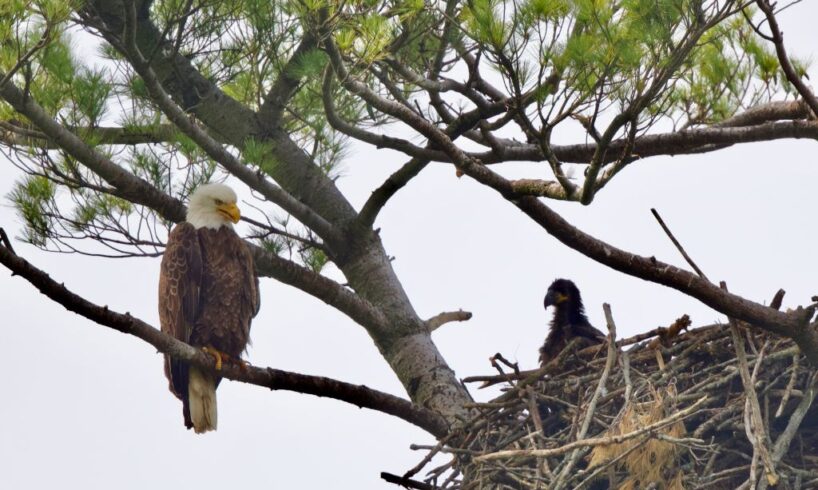
Emerging from a thicket behind me, the young bald eagle flew nervously across the river and crashed spectacularly into some tree branches, snapping them with an audible crunch.
I breathed a sigh of relief.
The day before was the eaglet’s first outside the nest, and another photographer had witnessed what he described as a possibly fatal collision with a thick tree trunk. Now I had proof of life.
Despite a few horrific tree collisions, an eaglet born this year is gaining confidence — and ability — in flight each day.
The following day I saw the eaglet feeding back at its nest, its parents making regular deliveries of prey which can include raccoon, mink, duck and fish. Bumps and bruises are an important part of an eaglet’s maturation, getting them ready to leave their parents’ nest.
Adult bald eagles tend to return each year to the same location, constantly maintaining their nests by adding sticks snapped from nearby trees. For six years I’ve observed and photographed similar incidents at a nest in Ayr, Ont., along the Nith River. Four years ago this pair actually did move — about 100 metres upriver — to another tall pine. Soil erosion below the original nest wouldn’t pass a home inspection, so this savvy pair picked a more stable site.
After delivering a meal, the adult male hurries away to search for additional prey to feed the insatiable appetite of his eaglets.
Nearly every year that I’ve been watching them, a new brood was born to the couple in Ayr. I’ve watched as they cater to their young, and teach them to hunt and fly. Although eaglets are almost fully grown at three months of age — and have closely studied their parents’ behaviour — they still have to figure out the mechanics of flight. Should they leap or flap their wings first? And what constitutes a safe landing?
Clumsiness is evident. A female fledgling crashed into a tree as she learned to fly in June 2021, then hung upside down for a minute or two until she got her bearings.
Some eaglets will assess the risk of flight, decide it’s too high and instead confine themselves on a branch for days. The adults will attempt to feed them in that position, but without a nest to catch them, meals often wind up on the ground below. It’s no wonder bald eagle mortality rates are roughly 50 per cent in their first year.
The adult male spotted movement below the nest and suddenly dove, vanishing into a marsh. He emerged with prey.
This female eaglet spent much of July 2020 perched on a branch after struggling to gain sufficient elevation to get back into the nest. The adult male brought her a fish and then fed her beak to beak.
Still, this is one of hundreds of bald eagle nests across the province, an amazing number given the threats to the birds and their habitat.
Bald eagles feed their young until they’re nearly fully grown. The parents will hunt and return to the nest with a baby raccoon like this one, or ducks, chickens, mink and fish.
The bald eagle population nearly collapsed in the middle of the last century due to pesticide use. Through bans and conservation efforts, it has gradually bounced back in recent decades, but while the bald eagle was removed from Ontario’s species at risk list in 2023, they are not out of the woods.
Lead poisoning is one major concern, as the birds are scavengers and can ingest ammunition fragments if they find an animal carcass left by hunters. Disease is another, as common prey such as waterfowl might carry avian flu, while mosquitoes are carriers of West Nile virus.
Like humans, neighbours can be a challenge for bald eagles. Relentless screeching red-winged blackbirds, as well as blue jays and grackles can be enough to send the eagles off to a new perch.
Intruders such as ospreys, turkey vultures, red-tailed hawks and even their own offspring from recent years often venture too close to bald eagle nests and are chased off. When an osprey approached, the adult male raised the alarm and gave chase.
Adult eagles in Ayr have become tolerant of human disturbances like trains, planes, noisy bonfire parties and fireworks, not to mention birders and photographers lined up along the riverbank. It’s a skill their young need to learn to survive.
The adults often provide flight demonstrations for their young. The eaglets watch carefully, then wildly flap their wings, mimicking the elders.
In August 2024, the adult male was preening in a nearby tree while the eaglet screamed for food. Finally, the adult flew away, returning a few minutes later with a northern pike. He dropped it by the river’s edge. It took a few attempts, but the eaglet managed to retrieve it. This was a hunting lesson provided by an expert fisher.
Over the coming weeks, they will practice tough love, spending less time at the nest so the young are forced to explore their surroundings. It’s a proven parenting method, implemented by a couple that has successfully raised dozens of eaglets.
They’ll enjoy a period of tranquility after the young leave to make their own territories. And by late autumn, the cycle will begin again.
Banner:
Every year, a couple of bald eagles in Ayr, Ont., teaches their young to hunt, fly and eventually fend for themselves.





